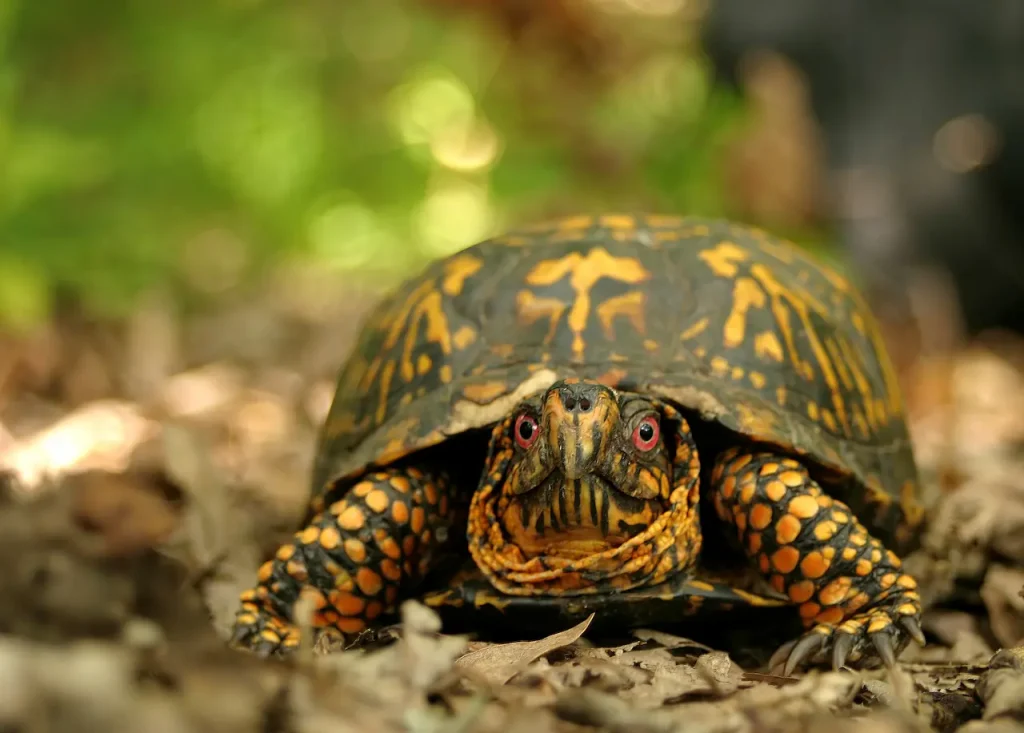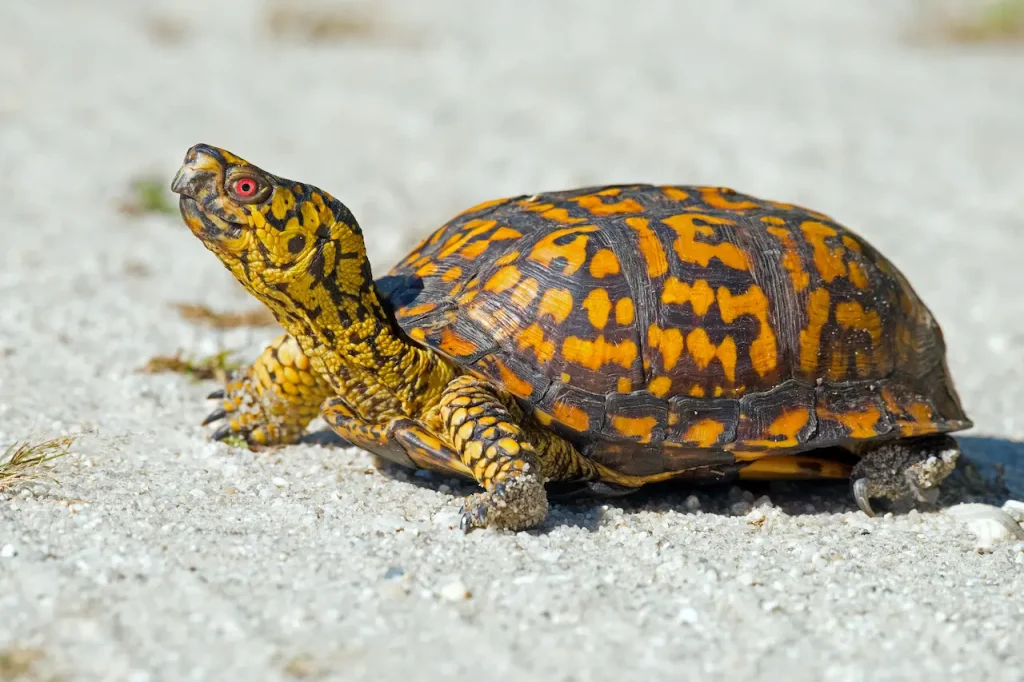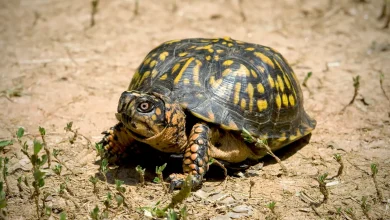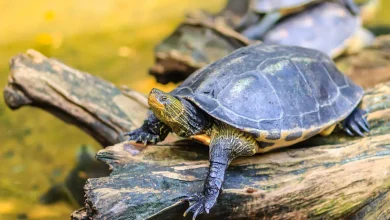Spotted Box Turtle (Terrapene Nelsoni)
The Spotted Box Turtle is a species of box turtle in the genus Terrapene.
- Spotted Box Turtle, Terrapene Nelsoni – Stejneger, 1925
It has two known sub-species:
- Northern Spotted Box Turtle (Terrapene Nelsoni Klauberi)
- Southern Spotted Box Turtle (Terrapene Nelsoni Nelsoni)
Table of Contents

Spotted Box Turtle Distribution
The Spotted Box Turtle is an endemic species. This means that it only lives in one isolated location. They can only be found in Sierra Madre Occidental, Mexico. Sightings and studies have been extremely rare. They have not been classified as endangered but obtaining one would likely be very difficult.
Spotted Box Turtle Habitat
A Spotted Box Turtles preferred microhabitat is still a subject of debate, due to the lack of study and rare findings. A consistent finding is that they like isolation, and their nests are hard to find
and access. Rarely has more than one been spotted in the wild, and the most ever recorded in one location was four. They are believed to only be active during the summer monsoon. Box turtles in general tend to live near a shallow body of fresh water. This is vital for their ability to cool down, rehydrate and hunt for insects.
Body
As one might guess, Spotted Box Turtles are identifiable due to unique spotted patterns. These spots occur on their shell, and are tiny numerous dots. As a species of box turtle, the Spotted Box Turtle has a hinged shell that allows it to enclose its body entirely; protecting its limbs from potential threats.
Sexing a Spotted Box Turtle
Box turtles can often be gendered by inspecting their lower shell. The male specimens tend to have a concave curve on their lower shell. The reason for this is that it helps them mount over the female during mating. The female’s lower shell will be flattered by comparison.
Spotted Box Turtle Video
What Does a Spotted Box Turtle Eat?
Box turtles have a mixed diet of both meat and plant matter. The proper term for this is “omnivore.” Box turtles are relatively small and tend to get most of their meat from insects, which are the most ideal prey. Slugs, snails, cockroaches, crickets, beetles and so forth all make great meals for a box turtle. Their diet in plant matter is quite varied. They like greens such as certain types of grass, lettuce, and moss. They also enjoy fallen fruits, berries, and even some fungi such as mushrooms.

How Old can a Spotted Box Turtle Get?
More studied species of box turtle have been estimated to live to around a hundred years in the wild. It’s currently unknown if this is true for the Spotted Box Turtle. Their estimated survival rate within captivity is a maximum of twenty-five years.
Keeping Spotted Box Turtles as Pets
The study of Spotted Box Turtles has been so insufficient that their official status as an endangered species status has never been specified. Sightings are rare, however, and acquiring one as a pet in the United States is both expensive and difficult to accomplish. Further, the profound lack of study for this species could make them harder to care for in comparison to other species of turtle.
They make a desirable specimen due to their unique spotted design. But trying to care for one is a bit of a gamble. Until further study and cultivation has been undertaken, their presence in the pet trade is small and has an uncertain future.
Housing a Spotted Box Turtle
Box turtles are often happiest when kept in an enclosure that they cannot see through. Glass is irritating for box turtles. They don’t understand the concept of it and will struggle against the invisible barrier indefinitely. Their thirst to escape can sometimes be quelled with an “out of sight, out of mind” logic. By keeping them in an enclosure they cannot see out of, they will be more at peace with their enclosure and experience less stress.
Humidity is important for a box turtle, and their enclosure must have a spray bottle used on it multiple times throughout the day. A source of fresh water is vital. This should be a wide, shallow water source that is large enough for the turtle to soak in. It has to be changed frequently and kept as fresh as possible.
Privacy is important to box turtles, even beyond what their hinged shell can provide. They desire things like brush and logs in their enclosure that they can hide in. They also need loose, soft bedding that they can burrow into. This makes them feel safer and can also help them cool off.
Reptiles cannot regulate their body temperature and their enclosure must provide this for them. A heating lamp often works best. This must be kept to one side of the enclosure so that the turtle can move closer to it, or further away from it as needed.
When taken from their home, a box turtle may never cease their urge to return to their birthplace. You have to make sure that the enclosure is escape-proof. They can try to chew or claw their way through the walls if you’re using a flimsy material, and if it’s an outdoor enclosure they may even try to burrow underneath it. Make sure they can’t get out and predators can’t get in.
Feeding a Spotted Box Turtle
You will have to balance their diet with a mixture of plant matter and animal protein. Insects are often the first choice for meat. They’ll hunt crickets and similar feeder insects you can buy at any pet store. In some cases, they will also eat things like baby mice, which can be bought frozen and then thawed.
For plant matter, you can give them things like lettuce and fruit. Sometimes they will have a favourite treat, like strawberries. Resist the urge to give them just their favourite; they need a variety of foods to get all their nutrients.
References
- Buskirk, J.R. and Ponce-Campos, P. 2011. Terrapene nelsoni Stejneger 1925 – Spotted Box Turtle, Tortuga de Chispitas, Tortuga de Monte. In: Rhodin, A.G.J., Pritchard, P.C.H., van Dijk, P.P., Saumure, R.A., Buhlmann, K.A., Iverson, J.B., and Mittermeier, R.A. (Eds.). Conservation Biology of Freshwater Turtles and Tortoises: A Compilation Project of the IUCN/SSC Tortoise and Freshwater Turtle Specialist Group. Chelonian Research Monographs No. 5, pp. 060.1–060.9, doi:10.3854/crm.5.060.nelsoni.v1.2011, http://www.iucn-tftsg.org/cbftt
- Bogert, Charles M. 1943. A new box turtle from southeastern Sonora, Mexico. American Museum Novitates (1226): 1-7.
- Enciso, S. F. 2002. Tortugas dulceacuícolas y terrestres de Sinaloa. Atlas de la Biodiversidad de Sinaloa. : 347
- Flores-Villela, Oscar / McCoy, C. J., ed. 1993. Herpetofauna Mexicana: Lista anotada de las especies de anfibios y reptiles de México, cambios taxonómicos recientes, y nuevas especies. Carnegie Museum of Natural History Special Publication, no. 17. iv + 73
- Iverson, J. 1982. Terrapene nelsoni. Catalogue of American Amphibians and Reptiles. (289): 1-2
- Lemos, J., Smith, H. y Chiszar, D. 2002. Terrapene nelsoni klauberi. Herpetological Review. 32 (4) : 274.
- Montes-Ontiveros, O. y Ponce-Campos, P. 2006. Terrapene nelsoni nelsoni (Southern Spotted Box Turtle). Herpetological Review. 37 (2) : 239.
- Shaw, C. E. 1952. Sexual dimorphism in Terrapene klauberi and the relationship of T. nelsoni to T. klauberi. Herpetologica. (8) : 39-41.


